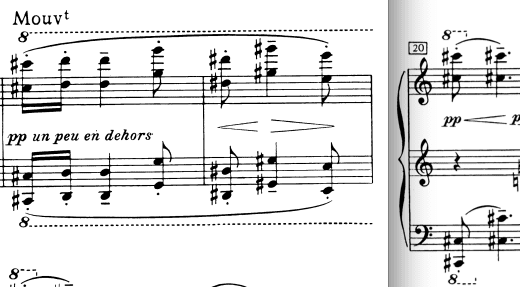Last week we looked at “Brouillards” from Debussy’s second book of Preludes. In this performance by Krystian Zimerman, you can hear Debussy’s interesting use of juxtaposition, which is the subject of this post . . .
https://www.youtube.com/watch?v=AhdXnMHqsEU
We analyzed the movement’s pitch structures, its form, and so on, but I was most fascinated by how the movement grows from a juxtaposition of material — a technique I often use in my own music. After its smooth and floating opening phrase, the flow is jolted by a staccato, multi-octave interruption in bar 5, which gets repeated (because this is Debussy, King of Repetition) in the (omitted) next bar:

Though brief, this interruption brings together several key elements: (1) a second hint of a wider registral range, which was first hinted at in bar 2; (2) the revelation of other layers of pulse, this one between the eighth note chords and the filigree; (3) an alternate world of articulation; and (4) the motive of a minor second, here presented as a minor ninth. The interruption also lays bare the superimposed tonal centers of the previous 4 bars (C against D-flat).
All these elements go by in flash, but even as the floating material regains equilibrium, Debussy begins to elaborate on them. The wider registral range was the piece’s first discontinuity (in bar 2), and Debussy begins his elaboration on the bar 5 interruption with that material. Once the supporting chords settle into the G-major above the initial C, Debussy arpeggiates an F-sharp major triad that spans three octaves (bars 12–14) and then contracts to its fifth, C-sharp, in octaves (bar 16).
Meanwhile, this arpeggiation has also introduced a still slower pulse level than we’ve yet heard in the piece. And with three pulse levels in place, Debussy drops the fastest one.
With elements (1) and (2) now prepared, Debussy brings in (3) and (4):

This melody feels stark because of its wide, bare octaves and its rate of movement that matches little in the first two pages. It feels all the more stark when it is then juxtaposed with the opening material (mm. 20–24), not only for the reasons discussed but also because of its center on C-sharp and its straight-forward chromaticism.
But it didn’t come from nowhere, and nor will Debussy use it like an isolated block simply to juxtapose with the opening material. In fact, I would contend that he intends to do something sonata-like with it. Note that this melody’s opening interval is the same as the measure 4 interruption, only compressed and transposed up a half-step. When the melody repeats, it closes by spelling an augmented triad rather than a minor one:

That closing intervallic relationship is the key to how Debussy ties back together these diverging worlds. But they converge, Debussy continues to elaborate on the idea of expanding register but having the filigree sweep up nearly the entire range of the keyboard (mm. 29–30):

Note that these sweeps leave out the contra-octave that was prominent in the contrasting melody (m. 20 ff.).
That octave remains in suspension during the filigree’s developmental time in the sun (mm. 24–37), which I will mostly skip over except to point out the descending diminished triad that can be heard as an echo of the descending triad figure in the examples 2 and 3 above:

This passage presents itself like a sequence and could have kept going similarly, except it is interrupted by the contrasting melody in the contra-octave that was missing from the upward sweeps:

Again, Debussy initially presents the version ending with a minor triad, but after the melody’s start is rhythmically compressed in bar 41 — almost coming, as it were, out of the filigree — Debussy creates an agogic accent on the melody’s ending triad, drawing even more attention to it by dropping the final interval to the piano’s lowest octave:

Instead of repeating the minor triad just ending an octave lower, Debussy finishes out the melody with an augmented triad, down to low C-natural. Now, Debussy had presented a version of the melody that ended with an augmented triad (ex. 3, mm. 23–24), only he made that triad by shifting the melody’s middle up a half-step. By letting the augmented triad play out here without that inner transposition, the melody flows into the opening material’s pitch collection. These worlds also converge in that the contrasting melody’s final four notes (mm. 41–43) shift from having a staccato articulation to having the legato articulation of the opening material. Thus, these two worlds that initially seemed starkly contrasted and neatly separated have blended into each other.
This blending and the elaborations that prepared it matter because they show how juxtaposition can be more than local disruptions without formal meaning. This possibility has fascinated me as a composer ever since I worked on These Distracted Times. I like the feeling created by weaving together disparate materials, and over the years I’ve learned how to do it better from Stravinsky, Brain Wilson, and just last week, from Debussy.
Sign up to stay in the loop about my music—and ideas for your own composing!

